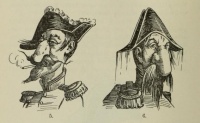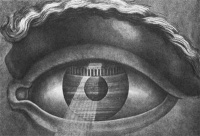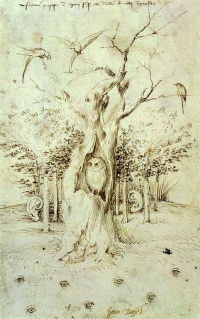Sense
From The Art and Popular Culture Encyclopedia

Illustration: Napoleon III nose caricatures from Schneegans's History of Grotesque Satire
|
"To arrive at the unknown through the disordering of all the senses, that's the point'. --Arthur Rimbaud, 1871 "(W)ith five feeble senses we pretend to comprehend the boundlessly complex cosmos, yet other beings with a wider, stronger, or different range of senses might not only see very differently the things we see, but might see and study whole worlds of matter, energy, and life which lie close at hand yet can never be detected with the senses we have ... strange, inaccessible worlds exist at our very elbows." --"From Beyond", H. P. Lovecraft |

Illustration: Drawing for the interior view of the Théatre de Besançon (1784) by Claude Nicolas Ledoux
|
Related e |
|
Featured: |
Senses are physiological capacities of organisms that provide data about the world; sight, smell, hearing, touch, taste. The senses and their operation, classification, and theory are overlapping topics studied by a variety of fields, most notably neuroscience, cognitive psychology (or cognitive science), and philosophy of perception. The nervous system has a specific sensory system or organ, dedicated to each sense.
Human beings have a multitude of senses. Sight (ophthalmoception), hearing (audioception), taste (gustaoception), smell (olfacoception or olfacception), and touch (tactioception) are the five traditionally recognized. While the ability to detect other stimuli beyond those governed by the traditional senses exists, including temperature (thermoception), kinesthetic sense (proprioception), pain (nociception), balance (equilibrioception), acceleration (kinesthesioception), and various internal stimuli (e.g. the different chemoreceptors for detecting salt and carbon dioxide concentrations in the blood), only a small number of these can safely be classified as separate senses in and of themselves. What constitutes a sense is a matter of some debate, leading to difficulties in defining what exactly a sense is.
Contents |
Culture
In the time of William Shakespeare, there were commonly reckoned to be five wits or five senses. At that time, the words "sense" and "wit" were synonyms, so the senses were known as the five outward wits. This traditional concept of five senses is common today, and Extrasensory perception is often called the sixth sense.
Depictions of the five traditional senses as allegory -- called allegory of the senses -- became a popular subject for seventeenth-century artists, especially among Dutch and Flemish Baroque painters. A typical example is Gérard de Lairesse's Allegory of the Five Senses (1668), in which each of the figures in the main group allude to one particular sense. There is also Allegory of the Senses, a painting by Jan Brueghel the Elder.
Etymology
From Old High German segisna, segansa (with metathesis), from Proto-West Germanic *sagisnu.
See also
- sight / vision
- hearing / audition
- taste / gustation
- smell / olfaction
- touch / tactition
- thermoception
- nociception
- equilibrioception
- proprioception
Namesakes
- The Logic of Sense (1969) by Gilles Deleuze
- In the Realm of the Senses (1976), a Japanese film
Further reading
- The Man Who Mistook His Wife for a Hat (1985) by Oliver Sacks
See also
- Attention
- Apperception
- Basic tastes
- Communication
- Empiricism
- Extrasensory perception
- Hypersensitivity (people with unusual sense abilities)
- Ideasthesia
- Illusions
- Intuition
- Nonsense and common sense
- Perception
- Phantom limb
- Sensation and perception psychology
- Sense of time
- Sensitivity (human)
- Sensorium
- Sensory system
- Sensor
- Synesthesia
- Word sense in linguistics, one of the meanings of a word




